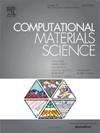First-principles design of high speed nanoscale interconnects based on GaN nanoribbons
IF 3.1
3区 材料科学
Q2 MATERIALS SCIENCE, MULTIDISCIPLINARY
引用次数: 0
Abstract
Investigation of efficient interconnects for upcoming nano-electronic devices is an active area of research. In the present work, we gauged the effect of O-passivation on zigzag GaN nanoribbons (ZGaNNR) as well as armchair GaN nanoribbons (AGaNNR) for interconnect applications. Various possible configurations of O-passivation were considered and the findings thus obtained were compared. It is reported that O-passivated ZGaNNR nanoribbons exhibit metallic character unlike H-passivated counterparts. On the other hand, the magnitude of band gap for AGaNNR is drastically reduced upon O-passivation. It is also noticed that replacing H with O for passivation purpose also enhances the structural stability of the ribbons making them preferable. The non equilibrium Green’s formalism coupled with density functional theory was employed to study the transport properties. The obtained current–voltage (I-V) characteristics confirm maximum current for O@both-edges while minimum current has been obtained for O@Ga-edge. The small-signal dynamic performance parameters such as , , and are derived using the two-probe model for the interconnect modeling. The O@N-edge functionalized ZGaNNR has the lowest values of (12.9 K), (8.60 pF/m), (358.511 nH/m), and quantum latency (0.111 ms) and higher Fermi velocity. Our work paves the way for the realization of low-power nanoscale high-speed interconnect applications.

求助全文
约1分钟内获得全文
求助全文
来源期刊

Computational Materials Science
工程技术-材料科学:综合
CiteScore
6.50
自引率
6.10%
发文量
665
审稿时长
26 days
期刊介绍:
The goal of Computational Materials Science is to report on results that provide new or unique insights into, or significantly expand our understanding of, the properties of materials or phenomena associated with their design, synthesis, processing, characterization, and utilization. To be relevant to the journal, the results should be applied or applicable to specific material systems that are discussed within the submission.
 求助内容:
求助内容: 应助结果提醒方式:
应助结果提醒方式:


